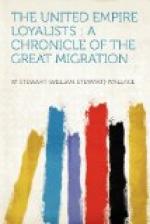It is evident from these early records that, while there were members of the oldest and most famous families in British America among the Loyalists of the Thirteen Colonies, the majority of those who came to Nova Scotia, New Brunswick, and especially to Upper Canada, were people of very humble origin. Of the settlers in Nova Scotia, Governor Parr expressed his regret ’that there is not a sufficient proportion of men of education and abilities among the present adventurers.’ The election in St John was a sufficient evidence of the strength of the democratic element there; and their petition to Governor Carleton is a sufficient evidence of their illiteracy. Some of the settlers assumed pretensions to which they were not entitled. An amusing case is that of William Newton. This man had been the groom of the Honourable George Hanger, a major in the British Legion during the war. Having come to Nova Scotia, he began to pay court to a wealthy widow, and introduced himself to her by affirming ’that he was particularly connected with the hono’ble Major Hanger, and that his circumstances were rather affluent, having served in a money-making department, and that he had left a considerable property behind him.’ The widow applied to Edward Winslow, who assured her that Mr Newton had indeed been connected—very closely—with the Honourable Major Hanger, and that he had left a large property behind him. ’The nuptials were immediately celebrated with great pomp, and Mr Newton is at present,’ wrote Winslow, ’a gentleman of consideration in Nova Scotia.’
During 1785 and subsequent years, the work of settlement went on rapidly in New Brunswick. There was hardship and privation at first, and up to 1792 some indigent settlers received rations from the government. But astonishing progress was made. ‘The new settlements of the Loyalists,’ wrote Colonel Thomas Dundas, who visited New Brunswick in the winter of 1786-87, ‘are in a thriving way.’ Apparently, however, he did not think highly of the industry of the disbanded soldiers, for he avowed that ’rum and idle habits contracted during the war are much against them.’ But he paid a compliment to the half-pay officers. ‘The half-pay provincial officers,’ he wrote, ’are valuable settlers, as they are enabled to live well and improve their lands.’
It took some time for the province to settle down. Many who found their lands disappointing moved to other parts of the province; and after 1790 numbers went to Upper Canada. But gradually the settlers adjusted themselves to their environment, and New Brunswick entered on that era of prosperity which has been hers ever since.
CHAPTER VIII
IN PRINCE EDWARD ISLAND
Not many Loyalists found their way to Prince Edward Island, or, as it was called at the time of the American Revolution, the Island of St John. Probably there were not many more than six hundred on the island at any one time. But the story of these immigrants forms a chapter in itself. Elsewhere the refugees were well and loyally treated. In Nova Scotia and Quebec the English officials strove to the best of their ability, which was perhaps not always great, to make provision for them. But in Prince Edward Island they were the victims of treachery and duplicity.




